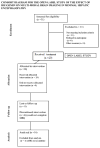Enhancement of functional connectivity, working memory and inhibitory control on multi-modal brain MR imaging with Rifaximin in Cirrhosis: implications for the gut-liver-brain axis
- PMID: 24590688
- PMCID: PMC4155029
- DOI: 10.1007/s11011-014-9507-6
Enhancement of functional connectivity, working memory and inhibitory control on multi-modal brain MR imaging with Rifaximin in Cirrhosis: implications for the gut-liver-brain axis
Abstract
Minimal hepatic encephalopathy (MHE) impairs daily functioning in cirrhosis, but its functional brain impact is not completely understood. To evaluate the effect of rifaximin, a gut-specific antibiotic, on the gut-liver-brain axis in MHE.
Hypothesis: Rifaximin will reduce endotoxemia, enhance cognition, increase activation during working memory(N-back) and reduce activation needed for inhibitory control tasks.
Methods: Cirrhotics with MHE underwent baseline endotoxin and cognitive testing, then underwent fMRI, diffusion tensor imaging and MR spectroscopy(MRS). On fMRI, two tasks; N-back (outcome: correct responses) and inhibitory control tests(outcomes: lure inhibition) were performed. All procedures were repeated after 8 weeks of rifaximin. RESULTS were compared before/after rifaximin.
Results: 20 MHE patients (59.7 years) were included; sixteen completed pre/post-rifaximin scanning with 92% medication compliance. Pre-rifaximin patients had cognitive impairment. At trial-end, there was a significantly higher correct 2-back responses, ICT lure inhibitions and reduced endotoxemia(p = 0.002). This was accompanied by significantly higher activation from baseline in subcortical structures (thalamus, caudate, insula and hippocampus) and left parietal operculum (LPO) during N-back, decrease in fronto-parietal activation required for inhibiting lures, including LPO during ICT compared to baseline values. Connectivity studies in N-back showed significant shifts in linkages after therapy in fronto-parietal regions with a reduction in fractional anisotropy (FA) but not mean diffusivity (MD), and no change in MRS metabolites at the end of the trial. A significant improvement in cognition including working memory and inhibitory control, and fractional anisotropy without effect on MD or MRS, through modulation of fronto-parietal and subcortical activation and connectivity was seen after open-label rifaximin therapy in MHE.
Figures




References
-
- Amodio P, Montagnese S, Gatta A, Morgan MY. Characteristics of minimal hepatic encephalopathy. Metab Brain Dis. 2004;19 (3–4):253–267. - PubMed
-
- Bajaj JS, Gillevet PM, Patel NR, Ahluwalia V, Ridlon JM, Kettenmann B, Schubert CM, Sikaroodi M, Heuman DM, Crossey MM, Bell DE, Hylemon PB, Fatouros PP, Taylor-Robinson SD. A longitudinal systems biology analysis of lactulose withdrawal in hepatic encephalopathy. Metab Brain Dis. 2012;27 (2):205–215. doi: 10.1007/s11011-012-9303-0. - DOI - PubMed
-
- Bajaj JS, Heuman DM, Sanyal AJ, Hylemon PB, Sterling RK, Stravitz RT, Fuchs M, Ridlon JM, Daita K, Monteith P, Noble NA, White MB, Fisher A, Sikaroodi M, Rangwala H, Gillevet PM. Modulation of the metabiome by rifaximin in patients with cirrhosis and minimal hepatic encephalopathy. PLoS One. 2013;8(4):e60042. doi: 10.1371/journal.pone.0060042. PONE-D-12-39836 [pii] - DOI - PMC - PubMed
-
- Bajaj JS, Heuman DM, Wade JB, Gibson DP, Saeian K, Wegelin JA, Hafeezullah M, Bell DE, Sterling RK, Stravitz RT, Fuchs M, Luketic V, Sanyal AJ. Rifaximin improves driving simulator performance in a randomized trial of patients with minimal hepatic encephalopathy. Gastroenterology. 2011;140 (2):478–487. e471. doi: 10.1053/j.gastro.2010.08.061. S0016-5085(10)01318-1 [pii] - DOI - PMC - PubMed
Publication types
MeSH terms
Substances
Grants and funding
LinkOut - more resources
Full Text Sources
Other Literature Sources
Medical

